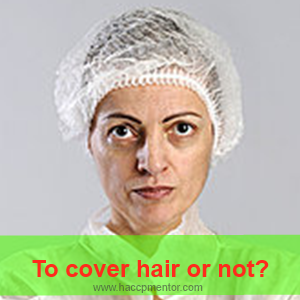Nobody likes getting hair in their food product, but to what extent do you go to with your preventative measures? Should you use hair nets? In episode 30 of HACCP Mentor Review we check out this issue along with some other food safety and HACCP compliance tips.
Watch Video
Welcome
Welcome to HACCP Mentor Review where each week I share my knowledge and insights around food safety and HACCP compliance. I am Amanda Evans and in this episode we find out how long records should be kept, discuss controlling hair contamination and we check out the requirements for selecting external test laboratories.
Record Retention
I often get asked how long you should keep your food safety program records. It really does depend on the record in question and also any over-riding legislation on record retention that is applicable to your country of manufacture. As a general rule, CCP, QCP and pre-requisite program records should be kept for the shelf life of your product plus 1 year. You will also need to consider the frequency of your external audit and also the requirements of your certification standard.
Selecting your Testing Laboratory
An external laboratory may be contracted to undertake various quality, chemical and microbiological tests for your business. There are lots of different laboratory’s to choose from but how do you know which one to select? Firstly you need to make sure that they can perform the analysis that you actually need on the type of food that you want to get tested. Also check that the laboratory is certified or accredited to undertake the tests that you require. To find out their accreditation status just ask the lab to provide a copy of their certificate and applicable testing scopes.
HACCP Plan Organisation
Just a quick reminder if you are looking for an electronic HACCP Plan organisation system to head over to www.haccpmanual.com where you can instantly download the HACCP computer folders. This is the same system that I use for all of my food business clients.
SQF Information Day
For those of you who are located in Australia and have SQF certification, I recommend you register to attend the upcoming SQF Information days that are being held in either Sydney or Melbourne. I will be presenting a session on the “Basics of a Facility Audit” at the Sydney information day on Tuesday 10th September 2013. Get in and register as places are filling up fast and don’t forget to come and say G’day.
Should you wear hair nets? 
Nobody likes getting hair in their food product, but to what extent do you go to with your preventative measures? The most common control is for food handlers to wear hair nets and beard nets but what about for people who are bald? Do you make it a condition that they have to wear hair nets? When implementing the wearing of beard nets, what is the allowable length of the beard or facial growth before someone has to wear a beard net? What about hair on the arms?
These questions can cause a fair amount of conflict in food business. I have audited companies that will stipulate that after the beard is a certain length, a beard net is to be worn. This sounds great in theory, but do they really go around and measure the length? Somehow I doubt it. Save yourself the stress and just make a blanket rule – all head hair is to be covered and if the person is not clean shaven, a beard net should be worn as well. Let me know your thoughts on this but leaving a comment below this episode.
Action of the week
The action to be completed this episode is to go around and check that all windows that can be opened in your food production facility are adequately screened and pest proofed. This includes checking that insect screens are tight fitting and don’t have any gaps around the edges where pests can crawl in and potentially end up in your food product.
Wrap Up
Well, that is episode 30 done. Please feel free to share this with any of your colleagues and associates. I also what to send out a quick thank-you to those who email me with your questions and appreciation. Thanks again, I am Amanda Evans, so until next time, stay safe and have a great week.




Are there any viable alternatives to a hair net? Surgical cap, skull cap, etc…would like something that I can have service by my uniform provider or autoclave in house. With the current Plandemic, suppliers anticipate a shortage of materials to make the hair nets in the near future.
Thanks for your question Ed. The first thing to do is go back to ‘what is the intent of wearing hair covering’. eg. To prevent hair from falling into food. If you can achieve that through some type of non-disposable head/ hair covering, I don’t see an issue. Just make sure they are regularly cleaned as you would any other type of protective clothing.
Than you!
do suppliers need to wear hairnet in dry store????
Really depends if you have identified hair contamination as a hazard, if there are any open products and the requirements of any 3rd party certification or customer standards.
I’ve read all the comments, along with all kinds of other sources of information. My question, playing devils advocate, is that if you don’t need to wear a beard net because you are clean shaven each day, why does a bald man who is clean shaven each day need to wear a hair net. Keep in mind that an effective hairnet for a bald man or even a head with stubble would be a poly bouffant. I’ve seen businesses force a bald man to wear a nylon hairnet for compliance with their policy, but a total failure to effectively control the risk itself. Yes, a blanket policy may make it easy to enforce, but what is the message being sent. It looks better, or we are doing the best possible. I chuckle at some food service industry locations where the hairnets are worn, the hair is sticking out of both the nylon and nylon honeycomb styles or just being worn like an old style beanie. A hairnet is no different than any other piece of personal protective equipment for the workplace. A proper risk assessment, suitable equipment to manage the risk, training in it’s use, and follow up my supervision.
I guess I saw the ultimate example the other day. The supervisor insisted two bald men, with clean shaven heads, wear a cheap nylon hairnet, but failed to mention beard nets to encase their long goatees. She was making sure everyone was the same.
Thanks Bruce for your feedback. The primary purpose of wearing hairnets or beard nets should always be to prevent hair from getting into food. Many companies find it easier to also enforce an “all-for-one” rule to help with compliance and the food safety culture within a food business.
Just thinking out loud here!
In all the comments posted I haven’t read anything about hazard. I.e, how dead will I be from ingesting someone’s hair? I can understand sharp objects of a certain size or contaminating a product with something that can give an allergic reaction, but hair? Choking hazard? Maybe biological hazards from bacteria? Though the amount will be insanely small I suppose, depending on how much you ingest.
Most standards state that facial hair covers must be worn if a risk and hazard analysis tells them to. How would an analysis like that look like? Chance X effect? Would love to see some calculations!
Of course hair does not belong in food products. Period. but making it a safety issue? Wouldn’t it make more sense if it were a quality issue?
As said, just thinking out loud here. Working in a production area myself and being a new member of the HACCP team.
Great question Matt. Hair generally falls under regulatory hazards but can also be a food safety issue (both physical and micro) depending on the amount as hair can get stuck in a consumers throat. The hazard analysis process requires us to identify all potential hazards and then indicate the likelihood and consequence of that hazard from occurring. Without a suitable control eg. hairnets, the likelihood will be obviously higher than what it would be with a control in place. Another issue that has the potential to occur is the transfer of Staph via hair onto a food product. You would then assess as a microbiological hazard ie. Staph due to contaminated hair falling from a food handler.
Hair nets, should it be worn by bald people. I have people complaining that it itches, and they have tried to wear it for a few weeks, and simply cant. Have you ever dealt with this kind of issue? Is it valid? How do you work around proving if a head is itching or not? Any advise
I can’t say I have come across this issue. For my consultancy clients it is a blanket rule that everyone wears hairnets (bald or not) to maintain a level playing field for everyone.
when preparing food for a organization should everyone wear hair nets and facial nets
Yes – based on risk and the legal requirement in your country of manufacture and export.
I agree all food handlers should wear hair and beard nets
Thanks Vanessa 🙂
Can I have an update on long hair tidiness of food servers on the floor please from anyone?
How it should be worn and what are the other options considering regulation and law?
Thanks
Hair should be secured and up-off the shoulders.
Hi,
Can we work in food production with having beard net on beard according to HACCP?
Or according to HACCP, is it mendatory to clean shave for working in food production area?
Thanks Yash for your question. You will need to refer to your company food handler hygiene policy. As a general rule beard nets are worn to prevent facial hair from contaminating the food product.
There are many conflicts we come across when making policies for food safety. Considering the beard, how we administer it is questionable. Working in a food processing area we are responsible to deliver a safe product to our customer. At this point how fit are we to the purpose needs to be decided. Are we to shave beard, arms is still questionable. As an organization we have requested all our employees to shave their beard. Imagine our customers spot our employees with beard. Though protective measures are taken how responsible do they think we are? My intention is not to rule out that everyone should shave before entering a food processing area. The question of how a customer would feel when observed a member working inside a food processing area with all the protective measures taken to prevent any form of contamination, the person under the cover is he or she really responsible, does their life pattern deliver a message that they are committed to food safety, etc.. Are we heading the right direction?
Thanks Marc, I agree….Perception is everything.
We are in Canada and starting HACCP training and certification. We produce many different types of packaging, retail, beverage trays and some bakery boxes as well. Do we need to enforce hairnets and or beard nets to get certified. Where can we get more information on this matter.?
Hi Brad
You will need to refer to the HACCP certification standard that you will be using. It will outline their expectations around the wearing of hairnets.
Hi Amanda
Is there any specific FDA guideline in which it describes about beard and requirement of nets in manufacturing areas?
Hi Shanavaz – the answer in sort is yes. You can find the text regarding the wearing of hairnets, caps, beard covers etc in § 117.10 Personnel (Part 117 – Current Good Manufacturing Practices, Hazard Analysis, and Risk-based Preventive Controls for Human Food, Subpart B – Current Good Manufacturing Practice)
hi may i know the hair net way to handle and how long can be used for one hand net. the hair net that already be used, is it need to discard daily or can be reuse for ho many time? and way to handle for it to be used again
Hi Nurul, as far as I know, disposable hairnets should be single use. This will also depend on the level of contamination or how dirty the hair-net is.
what are the rules on mustache how long before a beard net is needed
Hi Gary
As far as I know, there is no set actual length before beard nets should be worn. I use the rule of “if you can grab it with your fingers, a net must be worn”.
I agree with Amanda 100% no body wants hair in their food, and I personally believe it shows a “poor” GMP for any company that a hair is found in their product. I agree it should be 100% mandatory unless you are clean shaven for guys, and like Libia mentioned I like the idea of the employment requirement 😉 I saw one company that in its GMP it mentioned mustache is OK and you don’t need to have beard net, unless it is full beard!!! Make sence? I had the argument with them that hair is hair no matter if it is mustache ot beard! Thank you for the great work again Amanda 🙂
Thanks Kiano!
All food safety should be based on risk. So the question should be asked what is the risk of hair loss, how much, and from where. The risk of hair loss is more likely depending on the hair follicle depth. Follicle depth differs depending on where the hair is growing on the body, with the most shallow being on the top of the head. Beards do not generally shed hair, unless they are very long.
Having said this, it is much easier all round to apply the KISS principle (Keep It Simple Stupid) and have fewer and easier rules to implement. So, we apply a total hair net and beard snood policy in all “white” rooms.
Hair nets must be mandatory. Fortunately in our country we just ask all employees (working where food is handled) to be clean shaven ( a pre-employment requirement).
Our hair policy states
Facial hair (beard or moustache) is defined as more than 24 hours of growth
we also had to add
Hair nets or beard snoods must be removed before entering toilet or amenities areas
I think, use a hairs net and beard net is important in food production, But we can’t do the same thing for our hand, eyebrows, and thin hairs in the face (except you do a waxing for all over body ^^) So, maybe that’s why we need to use in line protection (such an air filter or strainer) in the production process.
Hi Amanda,
What about mustache, although face masks covers mustaches but may not retain detached hairs if any.
Regards
Sohail Anwer
I would just like to say that we require that all employees in the production areas must wear a hairnet regardless if they have no hair. Looks better and no argument as to how much hair. Beard nets must be worn if any facial hair. (even 5 o’clock shadow)
How about the forced removal of all hair (via waxing) of employees within the food industry on a daily basis. Can’t be too careful! 😉
Compulsory waxing…. Interesting Ben 🙂
What about beard nets in places that print products the food may go in. I work @one place were you do but I doubt the paper companies wear them so why do I need to. Another place I worked you only needed hair nets not beard nets. I think it’s just the shop I work at wanting to control people or try to force them to shave in the oppressive heat. Gets 85 + with humidity in the 30-50%. Causes your face to itch which is more of a chance of knocking hair lose itching threw out your shift. If hair was to fall on the product chances are it would be on top of the package and fall off before the final process.
It really comes done to risk Kochzilla and that needs to be determined by your QA team.
if you are not clean saven everyday you should wear bead net you should wear a hair net no matter what
Hi, Amanda.
I would just like to post a comment that was made to me about hair containment. An individual at a processor who had asked me to be a consultant asked about eyebrows. He thought that the whole “hair net” portion of the GMPs was bunk and eyebrows were his obvious objection. To me the comment of and by itself was stupid and just begging the question. How would you approach that?
Carlo
Cover eyebrows with hairnets maybe. Really needs to be based on risk.
I agree for the hair nets. We have in place if not clean shaved must have a beard net and all heads must be covered. In terms of managing any other rules or lenght limits it’s a big waste of time and energy for the quality team!